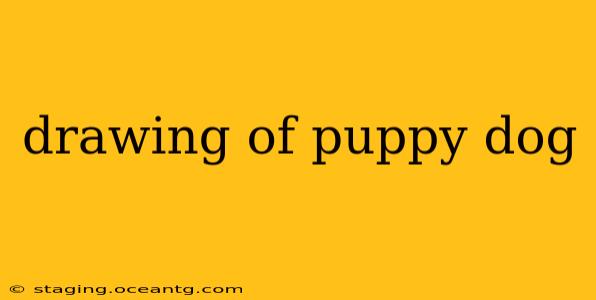Drawing a Puppy: A Guide for Beginners and Beyond
Drawing a puppy can be a fun and rewarding experience, regardless of your skill level. This guide will walk you through the process, from simple shapes to adding adorable details. Whether you're a complete beginner or looking to refine your skills, you'll find helpful tips and techniques here.
What Materials Do I Need to Draw a Puppy?
Before we begin, let's gather your supplies. You don't need expensive art materials to create a charming puppy drawing. Here's what you'll need:
- Paper: Any drawing paper will do, but thicker paper (like sketchbook paper) is preferable as it can handle erasing and layering better.
- Pencils: A range of pencils is helpful. A softer pencil (like a 2B or 4B) is great for shading, while a harder pencil (like an HB) is ideal for sketching outlines. An eraser is essential too!
- Optional: Colored pencils, crayons, markers, or paints for adding color once you've finished your pencil sketch.
How Do I Draw a Simple Puppy Face?
Let's start with a simple puppy face. This is a great starting point for beginners.
- Basic Shapes: Begin by sketching two circles – one slightly larger for the head and one smaller for the nose. Place the smaller circle slightly below the center of the larger circle.
- Eyes: Add two smaller circles inside the larger circle for the eyes. Position them symmetrically, slightly above the nose.
- Ears: Draw two floppy triangle shapes for the ears, one on each side of the head. Experiment with different ear shapes for variety.
- Mouth: Draw a curved line below the nose to form the mouth. Add a small tongue if you like!
How Do I Draw a Puppy's Body?
Once you have the head, it's time to add the body.
- Body Shape: Draw an oval shape connected to the bottom of the head. This will be the puppy's body.
- Legs: Add four small, slightly curved lines extending from the bottom of the oval. These will be the legs. Remember puppies have little chubby legs!
- Tail: Draw a curved line extending from the back of the body. This is the puppy's tail. You can make it wagging for extra cuteness!
What are Some Tips for Adding Detail and Realism?
To make your puppy drawing more realistic, consider these tips:
- Shading: Use your softer pencil to add shading to give your drawing depth and dimension. Pay attention to where the light source is coming from to determine where the shadows fall.
- Fur: Add small, short strokes to simulate the texture of fur. Vary the direction and pressure of your strokes for a more natural look.
- Features: Add details like whiskers, individual toes, and pupils to bring your puppy to life.
How Do I Draw Different Breeds of Puppies?
Different puppy breeds have distinct features. Research your favorite breed to understand its unique characteristics before you begin drawing. Observe photos or videos to learn about their ear shapes, body proportions, and other distinctive features.
What are Some Common Mistakes to Avoid When Drawing Puppies?
- Symmetry: Don't be afraid to make your puppy slightly asymmetrical. Perfect symmetry can look unnatural.
- Proportion: Pay attention to the proportions of the head, body, and limbs. Puppies have large heads compared to their bodies.
- Pressure: Use light pressure when sketching the initial outline. This allows for easy erasing and adjustments.
Drawing a puppy is a journey of practice and experimentation. Don't be afraid to try different techniques and styles. Most importantly, have fun and unleash your creativity! The more you practice, the better you'll become at capturing the charm and cuteness of these adorable creatures.
